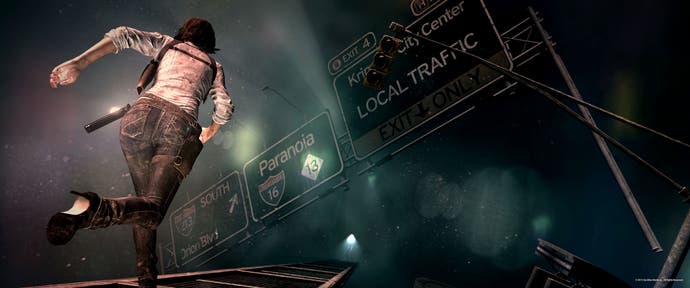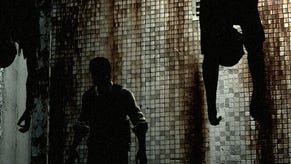The Evil Within: The Assignment and The Consequence review
Asylum partners.
If last year's The Evil Within saw Resident Evil creator Shinji Mikami reclaiming the survival horror gameplay he popularised, this double-whammy of DLC sees the genre pioneer playing around with toys from other horror games' playroom.
Taken together, The Assignment and The Consequence tell the story of Juli Kidman, erstwhile partner of the main game's hero, Sebastian, and explain just what she was up to during her prolonged absences from the core plot. It turns out that not only was she facing her own gauntlet of creepy beasts and unnerving boss fights, she was also involved in a plot that is arguably more important than Sebastian's B movie blundering.
Kidman is on the trail of Leslie Withers, the young male patient whose disappearance kicks off The Evil Within's original campaign. We learn that far from being some rookie partner cop, she's actually working undercover for a sinister agency, overseen by an ominous boss who is part Half Life's G-Man and part Slender. The storyline that follows is largely incomprehensible even by survival horror standards, told as it is largely through optional audio logs and text documents, with only the key plot points being laboriously spelled out in florid cut-scene dialogue.
It's in gameplay terms that this double bill of side story differentiates itself from its parent title. Where The Evil Within was pure survival horror, with ammo management, exploration and inventory-based puzzling, The Assignment and The Consequence are both stripped back to the bone. For the vast majority of their playing time, Kidman has no weapons and is armed only with a flashlight. Instead, evasion is her main skill. There were flourishes of this cover-based sneaking in the main game - most notably in that opening slaughterhouse chase - but this is pretty much a pure stealth game.

It's a choice that ensures these expansions feel very different, but it also pushes the game engine beyond what it's comfortably capable of. The jerky camera and stiff movement, so devilishly nostalgic during Sebastian's adventure as he roamed mansion corridors and carefully lined up headshots, prove far more deadly when used to deliver this amount of creeping around.
Entering and exiting cover is a stodgy affair, while running away when spotted is rarely successful thanks to Kidman's wheezing lack of fitness. She can jog maybe ten feet before stopping to catch her breath, and since these stories offer no upgrade paths, you're stuck with this bizarre lethargy for the duration. Balancing this out is the fact that you don't need health syringes to patch yourself up after a scrap. Simply remain still, or hide in cover, and Kidman is back to full health in a few seconds.
Recharging health in a survival horror game? You can probably hear the genre purists sucking their teeth in disapproval already, and it does feel that the odd balancing of the DLC is down to the limitations of the original engine coupled with make-do solutions to the problems that throws up.
The result is an experience that is both surprisingly easy and often frustrating. Whenever you die it's generally because of sluggish movement or unhelpful camera angles, but then trial and error gets you past most enemies without too much fuss. They're never very smart, but most are at least unique to this DLC.

There are blind crab-like corpse creatures that scuttle about in fixed patterns, only attacking with an instant death explosion if you bump into them. There are invisible enemies that only appear when caught in the glare of your flashlight. At best, you're able to take them down by finding hatchets and using them for a stealth kill. Inexplicably - and illogically - you can only do this once, the effort of retrieving these useful weapons from the bodies of enemies apparently too much effort for Kidman.
There are only a few moments where guns are used. One, in The Assignment, is a stationary shooting gallery where you don't get to keep the gun afterwards. The Consequence is a little more action-oriented, eventually granting you a pistol and later a shotgun. These prove essential against the game's Keeper boss character, which is basically Rocky Horror's Frank N. Furter crossed with a lighthouse by way of BioShock's Big Daddy.
In terms of pure mechanics, it's a real mixed bag. It's the context that really makes the difference, as both episodes are even weirder than the main game and take great delight in f***ing with your head. The bewildering location shifts come thick and fast - one of the benefits of having a mind-messing machine as your McGuffin of choice - and you're never entirely sure what's coming next.
Often, a new enemy or gameplay idea will be introduced for only a short while and then never used again. When so much DLC is blatantly an excuse to recycle assets, the willingness here to add fresh things is worthy of praise. When it does bring you back to familiar locations, it's always for a clever reason - playing with your knowledge of what else has happened in that spot, or offering a genuinely ingenious alternative perspective on things you did in the main story.

That generosity continues throughout, too. The collectables are nothing to get excited about - the same files and recordings scattered throughout the core game - and the only puzzles are simple and small in nature compared to Mikami's previous work. They really only come into play via a series of hidden safes, inside of which you'll find fragments of letters. Tucked away in self-contained secret areas, the solutions are almost always in the same room.
Yet when you finish both The Assignment and The Consequence, you'll unlock a New Game + option for those who fancy another run through, and Kurayami Mode, which ups the difficulty by switching off all the lights and forcing you to rely only on your flashlight to see what's going on. Coupled with the decent length of the episodes themselves - each lasting between three and four hours on average - and you've got DLC that goes above and beyond what is generally expected from add-ons released six months after a blockbuster launch.
I just wish it wasn't so clumsy where it counts, since there are few gameplay styles more off-putting than poor stealth, and the stealth here is often very poor indeed. Fans committed to the loopy storyline will probably be able to look past that and enjoy the surreal ride for its narrative and atmospheric pleasures. However, such frustrations can't help but drive a large rusty nail into the heart of an otherwise generous pair of expansions.

















